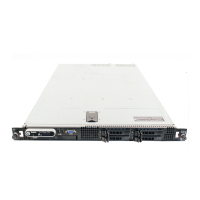Using the System Setup Program 41
Memory Information Screen
Table 2-3 lists the descriptions for the information fields that appear on the Memory Information
screen.
CPU Information Screen
Table 2-4 lists the options and descriptions for the information fields that appear on the CPU
Information screen.
Table 2-3. Memory Information Screen
Option Description
System Memory Size Displays the amount of system memory.
System Memory Type Displays the type of system memory.
System Memory Speed Displays the system memory speed.
Video Memory Displays the amount of video memory.
System Memory Testing Specifies whether system memory tests are run at system boot.
Options are Enabled and Disabled.
Redundant Memory
(Disabled default)
Enables or disables the redundant memory feature. When set to
Spare Mode, the first rank of memory on each DIMM is reserved
for memory sparing. See "Memory Sparing Support" on page 92.
Redundant memory feature is disabled if the Node Interleaving
field is enabled.
Node Interleaving If this field is enabled, memory interleaving is supported if a
symmetric memory configuration is installed. If this field is set to
disabled (the default), the system can support Non-Uniform
Memory architecture (NUMA) (asymmetric) memory
configurations.
NOTE: The Node Interleaving field must be set to Disabled when
using the redundant memory feature.
Table 2-4. CPU Information Screen
Option Description
64-bit Specifies if the installed processor(s) support 64-bit extensions.
Core Speed Displays the clock speed of the processor(s).
Bus Speed Displays the bus speed of the processor(s).
Virtualization Technology
(Disabled default)
Displays when the processor(s) support Virtualization Technology.
Enabled permits virtualization software to use Virtualization
Technology incorporated in the processor design. This feature can
only be used by software that supports Virtualization Technology.

